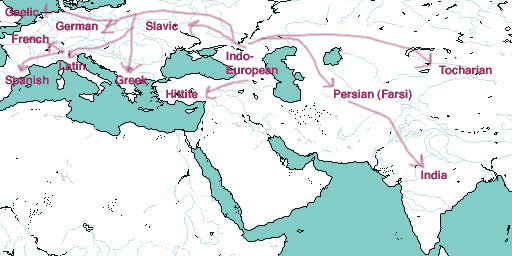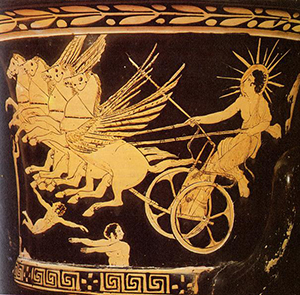
Yamnaya get around: Map of the spread of Indo-European languages
Who were the Yamnaya?
People we call the Yamnaya (Ukrainian for “People who lived in pits”) seem to have been speaking an early version of the Indo-European language at least as early as 5000 BC in the area between the Black Sea and the Caspian Sea, in what is now Armenia and Georgia.
Lifestyle of the Yamnaya
The Yamnaya were nomadic. They herded sheep through the grasslands, and moved around in horse-drawn wagons. Because there wasn’t a lot of wood on the grasslands, they may have burned coal for heat and cooking. By 4000 BC, most people in Central Asia, like the Scythians, spoke Indo-European languages. About 3000 BC, Indo-European language speakers spread east as far as western China and west as far as Ireland, with the Celts.

An Indo-European horse-drawn chariot from the Oxus Treasure (British Museum, thanks to Mary Harrsch)
Indo-European migrations
About 2100 BC, another group of Indo-European speakers left their home. Probably there was a climate change problem related to the drought that ended the Old Kingdom in Egypt, the Akkadian Empire in West Asia, and the Harappan civilization in India at the same time.
Hittites, Greeks, Romans, and Germans
Again, some went west and some went south-east, bringing their horses, their chariots, and probably their apples and carrots with them. Those who went west became the Hittites, the Greeks, the Romans, and the Germans.
Persians, Sogdians, India, China, Africa
Those who went south-east became the Persians, the Sogdians, and the Aryans who moved into northern India. Some went east and then south, bringing their horse-drawn chariots, bronze, coal, and possibly writing to Shang Dynasty China. By about 200 BC, the Roman Empire was spreading Indo-European languages to North Africa too.

Phaethon drives Helios’ chariot on a Greek red-figure vase painting from the 400s BC
Islam and the Mongols
By about 1000 AD, although people continued to speak Indo-European languages all over Europe and in Iran and northern India, fewer people spoke Indo-European languages in North Africa and Central Asia, the original homeland.
In North Africa, the spread of the Islamic Empire encouraged people to start speaking Arabic. In Central Asia, conquests by Turkic-speaking people like the Rouran and the Uighurs encouraged more and more people to start speaking Turkic. By the 1200s, Turkic-speaking people like the Seljuks, and then the Ottomans and the Mongols, ruled West Asia as well.
Indo-Europeans spread to the Americas, Africa, and Australia
Soon after 1500 AD, however, many more people began to speak Indo-European languages as invadng Europeans brought English, Spanish, and Portuguese to their colonies around the world. In South America and along the coast of California, people began to abandon Inca and Maya for Spanish and Portuguese. Thousands of English, Dutch, and German speakers settled in eastern North America, South Africa and Australia, as well. Just under half of the people in the world today speak an Indo-European language.
This map spread of Indo-European languages is entirely wrong, the Out of Caucuses theory is false and has been debunked and refuted many times. The current thesis is that IE languages spread to Europe from Central Asia and Iran and not the reverse. Also there was no movement of such peoples from the Caucasus region to India and the Aryan migration theory of India has been refuted and debunked many times already now….’
Many people have tried to refute it, but they have not succeeded.
It has not been refuted, to my knowledge, by any acceptable evidence. It still makes the most sense to this day. Also, how do you explain the existence of the pashun and Iranian nordoids?
yo